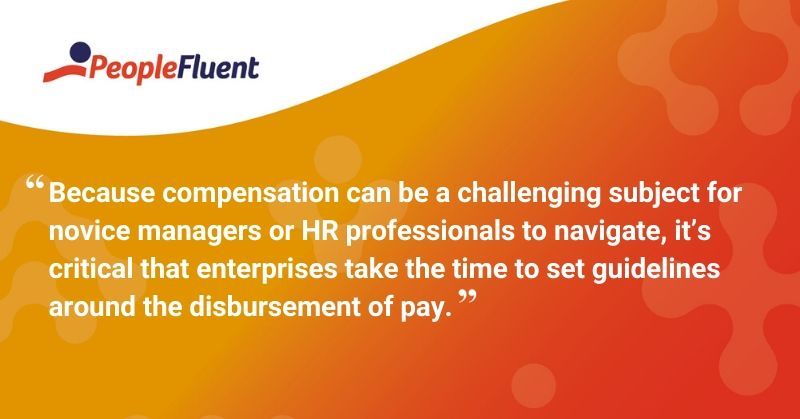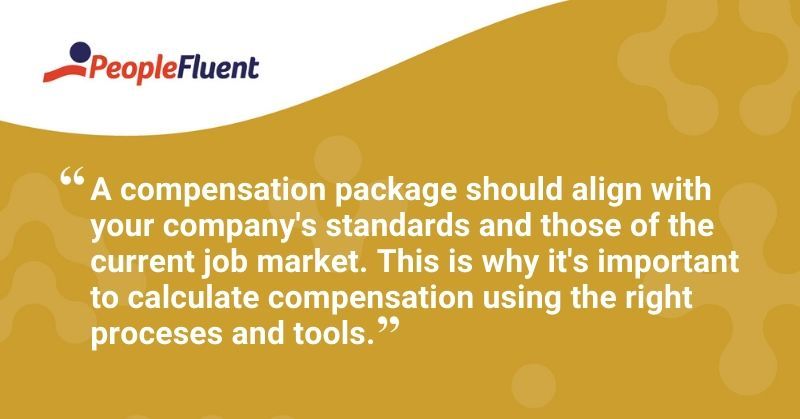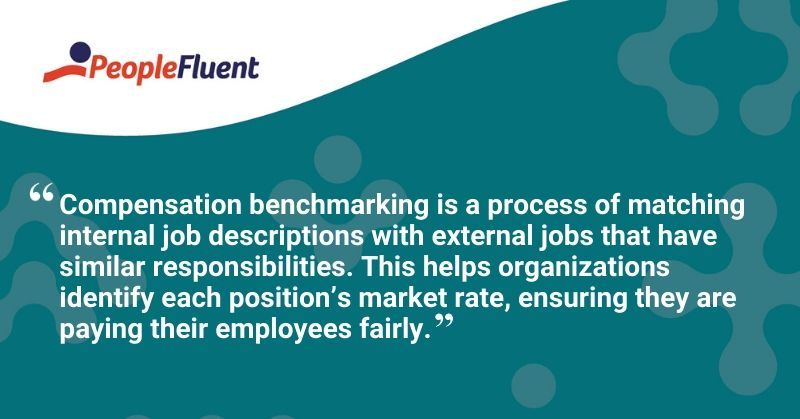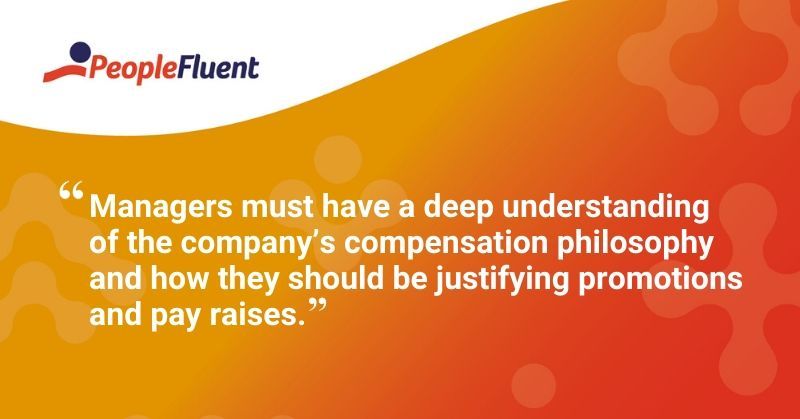Published: Apr 24, 2020Time to read: 12mins Category: Compensation
The Top 4 Benefits of Using Compensation Management Software
With the growing diversity of our workforces, it’s more important than ever for HR teams and business leaders to find creative ways to keep employees engaged and motivated. To ensure your employees’ expectations and needs are being met, it’s critical that they’re properly rewarded. Companies must go beyond manual salary planning and examine the benefits of using compensation management software. With the proper tools, your organization can account for the many factors included in a total rewards program and help HR leaders streamline their processes.
Are you looking to move away from using spreadsheets to manage your organization’s compensation planning? When considering how to keep your top performers and in-demand talent motivated and productive, it’s important to note that HR teams also need to feel valued. Could deploying capable compensation management software be a good way to achieve the latter?
In this article, we take a deep dive into the many moving parts of compensation planning while examining why organizations should be using a compensation solution. Finally, we’ll outline the top benefits of using compensation management software and how to make the business case for adopting tools that help HR teams efficiently plan and deploy the disbursement of total rewards.
What is Compensation Planning?
Compensation planning accounts for the many factors that make up an employee’s pay. In other words, compensation planning is the process of strategically choosing which elements to include in your compensation packages. The overall goal should be developing a compensation package that aligns with market wages and takes into consideration your company’s salary budget requirements.
Because compensation can be a challenging subject for novice managers or HR professionals to navigate, it’s critical that enterprises take the time to set guidelines around the disbursement of pay.
A compensation plan should include several elements of a compensation package, such as:
- wages
- salaries
- benefits
- bonuses and incentives (like stock options or meal plans/gym memberships and other applicable perks)
A compensation plan should also include how the package will be paid along with an outline of when and how employees will receive bonuses, incentives, and pay raises. This is especially important during the recruiting and hiring phases as well as during performance reviews that may warrant a pay raise or other incentives.
Compensation plans can look very different from one company to another but each plan should account for the varying types of compensation listed above. Compensation planning may not seem to be an intricate process, but it’s essential for organizations to take extra time and pay careful attention to detail when creating one.
A compensation strategy can be a valuable tool for recruiters as they try to attract the best possible hires and for managers striving to retain talent. Giving your candidates a clear view of the compensation package prior to and at the onset of employment helps your company remain competitive and offers transparency—two critical factors in becoming an employer of choice.
Related blog content: '4 Tips to Pay Transparency Success'

Why Do I Need Compensation Planning Software?
Any savvy business leader and HR professional knows that in order to retain top talent, companies must take a calculated approach to compensation planning. To be successful, proper compensation planning requires more than spreadsheets. Not only can you end up losing money by overpaying a new hire, your organization can also lose existing employees to competitors if you’re underpaying them.
You might also like: '4 Dangers of Using Spreadsheet Templates for Compensation Planning'
Below are the top four benefits of using compensation management software:
- Error reduction: By using spreadsheets and multiple programs to manage compensation planning, the margin for error is high. Having all of the data and tools necessary in one program significantly reduces the risk for human error. Administrators can also implement user-based restrictions and budget controls as failsafes. This means entering the wrong information would lead to an alert, ensuring the error is caught ahead of time and the user can be properly trained before utilizing the compensation software again.
- Save valuable resources: During the compensation planning cycle, organizations allocate more time into completing the process. Whether you’re looking to shore up your HR staff for other priorities or you’re interested in streamlining your compensation planning, having all the data and programs in one place is critical. For example, by utilizing compensation management software, Schwan’s Company reported a 30% reduction in their compensation cycle-time.
- Enhanced data protection: As data protection and security become more important for companies to prioritize, compensation management software can help ensure your company information isn’t left to chance. Deploying a compensation management tool that has customizable access controls and enhanced security features means your compensation data and employee information is protected against unauthorized access.
- User-friendly software: While most of us have learned to live in the world of multitasking, compensation planning shouldn’t be another checklist item. This central function of your business requires immense attention to detail, data analysis, as well as thoughtful and strategic planning. Clicking through endless spreadsheets while trying to navigate intricate data and analyze it all at once is neither efficient nor is it user-friendly. Having a compensation software program at your fingertips makes the process less cumbersome and more accurate.
For more on PeopleFluent’s compensation solutions, download the Compensation Product Sheets for large enterprises and mid-enterprises businesses.

How Do You Calculate Compensation?
A compensation package should align with your company’s standards and those of the current job market. This is why it’s important to calculate compensation using the right processes and tools. HR partners and business leaders should have a well-thought-out and strategic plan in place for calculating compensation to ensure nothing is missed.
Start with the following when looking at the many factors to consider when calculating compensation:
- The current job market: You should consider your existing and future headcount, location, industry, and the competition. For instance, if you’re looking to hire software developers in an area that has a large number of open roles for software developers, your compensation package should be more competitive.
- Possibility for growth: In lieu of a higher compensation package, some companies may offer rapid upward mobility. This means a position with a salary range of $45,000-$60,000 may settle on $45,000 with opportunities for growth. This offers an ROI for both the candidate and company.
- Employee value proposition: It’s important to consider your company’s compensation practices and how they translate to company culture. Employee value proposition is your organization’s set of values that allows you to attract, retain, and engage employees. It can be summed up as what your company is able to offer its employees.
- General considerations: There are many variables outlined in this list, but the more general factors should not be overlooked. These are things like an employee’s title, specialized skill sets, their level within the company, and individual considerations based on the candidate or existing employee.
- Compa ratio: Sometimes referred to as a ‘comparison ratio’ or ‘compensation ratio’, a compa ratio can help businesses calculate how much of an increase to pay an existing employee. A compa ratio is a percentage that can be obtained by dividing an employee’s actual salary by the salary midpoint range for that role. It’s an essential tool for helping companies determine how much of a raise to give an employee.
Given the intricate nature of compensation planning and the many factors that go into deciding on a compensation package, it’s easy to see why compensation management software is a necessary tool for any company looking to fairly and competitively compensate their employees.
Why not read: '8 Factors for Comparing Compensation Management Tools'
How is Compensation Benchmarking Done?
Compensation benchmarking, or salary benchmarking, is a process of matching internal job descriptions with external jobs that have similar responsibilities. This helps organizations identify each position’s market rate, which ensures employees are being paid fairly.
Compensation benchmarking begins with building a list of salary ranges for current and future roles. You can use salary information obtained from your salary data, salary surveys, or from an outside consulting firm. Then, you can calculate pay grades by considering your organization’s size, the hierarchy range between the lowest and highest ranking positions, and how your pay increases or promotions are determined.
To determine the salary ranges, you can use your previously-established pay grades. Using salary data, find the midpoint of the market value for each job and calculate the range between the minimum and maximum salaries for that role. Refer back to the midpoint market value as a guide to determine the minimum and maximum salary range for each role. It’s important to note that pay grades can also be determined without compensation benchmarking by utilizing the compa ratio mentioned above.
Compensation benchmarking is best completed after doing a thorough market analysis. Benchmarking is designed to ensure fairness for the employee and employer so it should be done with the help of customizable compensation management software.

What is a Compensation Structure?
A compensation structure is a group of jobs that are assigned salary ranges based on the organization’s hierarchy. There are two methods companies can use to develop compensation structures: benchmarking and pay grades. Benchmarking will ensure each job is assigned an individual salary range based on market trends while pay grades are composed of the internal and external value of the job market. Most companies will use both of these methods in tandem as benchmarking guides the creation of pay grades.
These structures are integral in determining an individual’s compensation, but also for a company to remain compliant. For example, using alternatives to set up formal pay structures, such as a candidate’s salary history or figures that may be deemed arbitrary (such as paying an employee more or less than the pay grade for their job) can lead to suspicions of discriminatory pay practices. That’s why using the proper tools to develop your compensation structure is highly recommended, especially for companies with a headcount greater than 250 employees.
Furthermore, benchmarking will help your organization remain competitive and result in attracting and retaining top talent while pay grades can help you achieve predictability and compliance.
Keep reading: 'Why It's Time to Abandon the Merit Matrix'
How Do You Develop a Compensation Structure?
Before a compensation structure can be developed, HR professionals and executives must work together to conduct a thorough job analysis and evaluation. If there’s no existing job description for a particular position, speak with the applicable department heads to decide on the job requirements, duties, and qualifications necessary for each role. You can also browse similar jobs within the industry to see what competitors are listing in job descriptions.
Next, you should work with the senior leadership, such as the CHRO and/or CFO, to perform a job evaluation. This helps you determine the relative value of positions in your company. You will need to compare each role with others in accordance with the most important criteria such as:
- responsibility level (e.g. associate versus supervisor)
- knowledge and skills required
- impact on revenue
- time and effort required
At this stage in structuring a compensation strategy, it’s best to have an unbiased opinion to help guide your decisions. This can be an external consultancy group or analyst who can allow you to see the difference between jobs and employees.
Whether your compensation structure will take the form of benchmarking or pay grades, you’ll likely end up using both or a combination of the two. The process of developing a compensation structure is complex but it’s crucial to your organization’s success. While it’s not a “set it and forget it” strategy, compensation structure should only require revisions every 12 to 18 months.
During market fluctuations, like an unemployment rate increase or recession, it’s recommended that you perform another analysis. Here are a few questions to ask to determine if it’s necessary to revise pay structures:
- Do we need to place new positions within our pay structure?
- Do our salary ranges align with the correct organizational levels?
- Do our candidates and employees find our compensation plans and pay structures fair?
- Is the existing pay structure appropriate for our career development and succession plans?
- Are our salaries still competitive in the current market?
More from the blog: ‘Beyond Ratios and Raises: 3 Compensation Strategies for Better Outcomes’

The Business Case for Compensation Planning Software
It’s understandable that decisions about compensation may be challenging to discuss with your management teams, but it’s necessary to have these conversations. Managers must have a deep understanding of the company’s compensation philosophy and how they should be justifying promotions and pay raises. Have a plan in place to discuss compensation plans and/or any budget changes so your managers have a clear picture of the company’s expectations around pay when hiring or promoting employees.
Getting compensation right is increasingly important for organizations. It often means the difference in retaining top talent, reducing turnover, driving greater profitability, and creating competitive advantage. Having the right, fit-for-purpose compensation management software can help take the guesswork out of pay and reward planning and provide much needed predictability for managing the organization's biggest expense.
To learn more about the benefits of compensation management software, read the ebook: ‘3 Strategies to Increase Compensation ROI: A Guide for Enterprise Organizations’ or contact the PeopleFluent sales team today.
Discover How to Reward People and Stay Competitive
PeopleFluent software provides the tools to help you plan and execute complex compensation plans, so you keep within your budget while attracting, rewarding, and retaining top performers.
